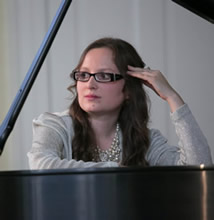The following preview was provided by the Raleigh Chamber Music Guild.
On Sunday, November 2 at 3:00 pm, two of our area’s most eminent musicians join forces for what promises to be a memorable offering. Cellist Emanuel Gruber and pianist Keiko Sekino will perform sonatas for cello and piano by French composers Claude Debussy, Francis Poulenc, and César Franck. Mr. Gruber and Ms. Sekino are faculty members at the School of Music of East Carolina University in Greenville, North Carolina. The concert is sponsored by the Raleigh Chamber Music Guild, and is the third installment in this season’s Sights and Sounds on Sundays series, held at the North Carolina Museum of Art. In a recent interview with Mr. Gruber, I got a glimpse into the mind of someone who is uniquely qualified to explore the connections between art and music, which is a hallmark of this series.
Claude Debussy (1962-1918) wrote his Sonata for Cello and Piano in 1915. Debussy is often considered the father of modern music, and is famous for forging new ground in nearly all of his compositions. In the cello sonata, he looks both forward and backward at the same time. Structurally, Debussy harks back to his great French baroque predecessor François Couperin, and constructs the sonata according to eighteenth-century conventions of form. Harmonically, he utilizes modern devices such as pentatonic and whole-tone scales. The cellist is called upon to execute striking techniques such as false harmonics, flautando and spiccato bowing, and left-hand pizzicato. In considering the overall mood of the piece, some speculate that Debussy may have had Pierrot in mind, the tragi-comic clown of the Commedia dell’arte, who is often characterized by grotesque movements, and has an obsession with the moon that sometimes leads him to the brink of insanity.
Mr. Gruber draws a parallel between this music and the sculptures of Auguste Rodin, specifically The Kiss (1882) and The Thinker (1904). In these, Rodin shows a willingness to depart from the classic beauty and perfection of form found in ancient Greece, and instead focuses on individual characters and their emotions, sometimes twisted and grotesque like Pierrot.
Francis Poulenc (1899-1963) wrote his Sonata for Cello and Piano in 1948. Poulenc was a member of the group of French composers known as Les six. These composers rejected the late Romantic styles of Wagner and Strauss, and even the impressionism of Debussy and Ravel. Instead, they concentrated on satire and even a touch of cynicism in their music. Popular styles of music were often a source of inspiration for these composers. Poulenc weaves popular elements into the cello sonata, sometimes in a humorous or cynical way, sometimes in a grotesque way. The work is dedicated to the cellist Pierre Fournier, with whom Poulenc closely collaborated in writing the cello part.
Mr. Gruber speaks of The Green Bridge by Lyonel Feininger as a possible artistic parallel to Poulenc’s music. This painting from 1916 depicts figures crossing underneath a green bridge, but their forms are distorted and somewhat grotesque. The painting captures a sense of irony that is of the essence of the music of Poulenc and his colleagues in Les six.
Cèsar Franck (1822-1890) composed his Sonata for Violin and Piano in 1886 as a wedding present for his friend, the great violinist Eugène Ysaÿe. Some speculate that this piece may have originally been conceived as a cello sonata, but when a commission for a violin sonata arrived from Ysaÿe, Franck recast it for that instrument. A version for cello followed soon after the violin version, done by the renowned cellist Jules Delsart. Attesting to its great appeal and popularity, other versions of this sonata exist for viola, flute, alto saxophone, tuba, organ, and solo piano. But the cello version is the only one of these that had the explicit sanction of the composer.
The work is cyclic in nature, achieving a unity of thematic content between the first and fourth movements. The piano part stands out as particularly demanding, when compared to other works in the chamber music repertoire. Due to the work’s popularity as a violin sonata, Mr. Gruber commented that one of the challenges for the cellist is to play it as though it were originally written for cello. He added that his teacher, Gregor Piatigorsky, refused to play it because of its associations with the violin.
An artistic parallel to producing several versions of the same musical work exists in the paintings of Claude Monet, specifically his series of paintings entitled Mornings on the Seine. Monet began this series of approximately twenty paintings in 1886, and concluded it in 1887. Here, we are given a glimpse into the interpretations of an artist painting the same scene at different times of day and different seasons of the year. In much the same way, the several different versions of Franck’s sonata give us an opportunity to consider the music from a variety of perspectives.
Mr. Emanuel Gruber is professor of cello at the School of Music at East Carolina University in Greenville, North Carolina. He has served previously on the faculties of the Rubin Academy in Tel Aviv, and at the Jacobs School of Music of Indiana University. Formerly the principal cellist of the Israeli Chamber Orchestra, he was awarded the Pablo Casals Prize by the Israel Philharmonic Orchestra in 1970, and won the Concert Artists’ Guild Auditions in 1975.
Dr. Keiko Sekino is professor of piano at the School of Music at East Carolina University. She holds the DMA degree from the Peabody Conservatory, and has performed extensively throughout the United States, Japan and Europe, including concerts in Carnegie Weill Recital Hall, Bennett-Gordon Hall at Ravinia Park, and Palacio de Festivales de Cantabria. She has appeared in master classes with many eminent pianists, including Leon Fleisher, Claude Frank, Boris Berman and Richard Goode.
Kent Lyman













